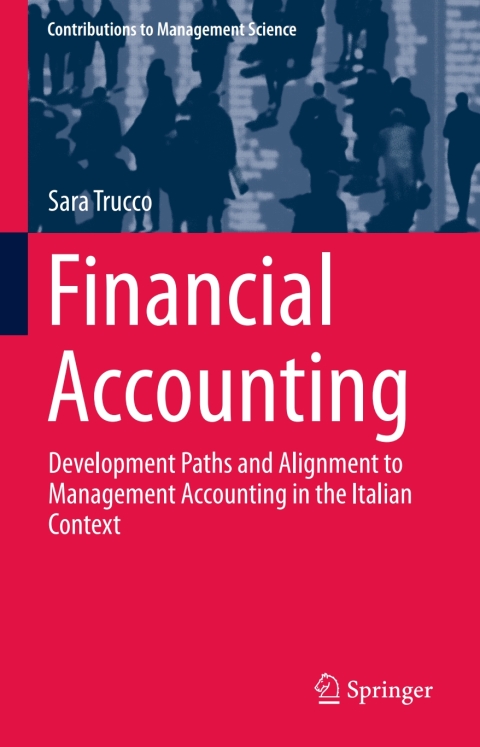Description
Efnisyfirlit
- Contents
- Chapter 1: Introduction
- 1.1 A Brief Overview of the Book
- 1.2 Theoretical Contributions of the Present Work
- 1.3 Practical Contributions of the Present Work
- 1.4 Structure of the Book
- References
- Chapter 2: Financial Accounting: Development Paths
- 2.1 Introduction
- 2.2 Financial Accounting: A Possible Framework
- 2.2.1 Financial Accounting: An Objective Perspective
- 2.2.2 Financial Accounting: A Subjective Perspective
- 2.3 The Role of Voluntary, Non-financial and Forward-Looking Disclosure in Financial Accounting Info
- 2.3.1 Mandatory and Voluntary Disclosure: First Level of Analysis
- 2.3.2 Financial and Non-financial Information: Second Level of Analysis
- 2.3.3 Forward-Looking and Historical Information: Third Level of Analysis
- 2.4 Theories for Supporting and Containing the Evolution of Financial Accounting: An External Perspe
- 2.4.1 Agency Theory
- 2.4.2 Signalling Theory
- 2.4.3 Legitimacy Theory
- 2.4.4 Constraints on Additional Disclosure
- 2.5 Internal Determinants of Financial Accounting Development Paths
- 2.5.1 Institutional Theory
- 2.5.2 Corporate Governance and Culture
- References
- Chapter 3: Premises for the Convergence of Financial Accounting and Management Accounting
- 3.1 Introduction
- 3.2 A Promising Relationship
- 3.2.1 The Debut of “Control´´
- 3.2.2 The Internal Control System
- 3.2.3 A Brief Focus on Management Accounting
- 3.2.4 The Link Between Financial Accounting and Internal Control Systems
- 3.2.5 The Virtuous Circle Between the Forward-Looking Perspective of Financial Accounting and Forwar
- 3.3 Premises for the Convergence
- 3.3.1 Premises for Convergence in an International Setting
- 3.3.2 Premises for Convergence in the Italian Setting
- 3.4 Convergence or Divergence of Financial Accounting and Management Accounting: Differences Among C
- References
- Chapter 4: Drivers of the Alignment of Financial Accounting to Management Accounting
- 4.1 Introduction
- 4.2 Institutional Theory in Support of the Convergence Process of Financial Accounting and Managemen
- 4.3 The Viewpoints of Professional Associations and Academics
- 4.3.1 IAS/IFRS: A Possible Driver of the Convergence Process Between Financial Accounting and Manage
- 4.3.2 Fair Value: A Possible Driver of the Convergence Process Between Financial Accounting and Mana
- 4.4 The Role of Information Technology on the Convergence Between Financial Accounting and Managemen
- References
- Chapter 5: Financial Accounting and Alignment to Management Accounting in the Italian Context
- 5.1 Introduction
- 5.2 Research Hypotheses and Research Design
- 5.2.1 ERP and the Convergence of Financial Accounting and Management Accounting
- 5.2.2 IAS/IFRS and the Convergence of Financial Accounting and Management Accounting
- 5.2.3 Integration of Accounting Systems
- 5.2.4 The Research Design
- 5.3 Sample Selection and Data Collection
- 5.4 Variable Measurement
- 5.4.1 Exogenous Variables
- 5.4.2 Endogenous Variables
- 5.4.2.1 Integration of Accounting System Variable
- 5.4.2.2 Perceived Quality of Financial Accounting Variable
- 5.4.2.3 Perceived Quality of Management Accounting Variable
- 5.4.3 Control Variables
- 5.5 Pilot Interviews: Preliminary Analysis
- 5.5.1 Financial Accountant Interviews
- 5.5.1.1 Financial Accountant Interviews: The Development Path of Financial Accounting
- 5.5.1.2 Financial Accountant Interviews: The Changing Role of the Financial Accountant
- 5.5.1.3 Financial Accountant Interviews: The Convergence of Financial Accounting and Management Acco
- 5.5.2 Controller Interviews
- 5.6 Survey Analysis
- 5.6.1 Descriptive Statistics
- 5.6.2 Statistical Model
- 5.6.3 Reliability and Validity of PLS-SEM Models
- 5.6.4 Empirical Findings
- 5.6.4.1 Empirical Findings: PLS-SEM Analysis on the Whole Dataset
- 5.6.4.2 Empirical Findings: PLS-SEM Analysis for the Sub-dataset of Financial Accountants
- 5.6.4.3 Empirical Findings: PLS-SEM Analysis for the Sub-dataset of Controllers
- 5.6.4.4 Summary PLS-SEM Results for the Three Samples of Respondents
- Appendix: Survey
- Personal Features
- Firm´s Features
- Convergence of Financial Accounting and Management Accounting
- References
- Chapter 6: Discussion on the Alignment of Financial Accounting to Management Accounting in the Itali
- 6.1 Introduction
- 6.2 The Antecedents and Consequences of the Alignment of Financial Accounting to Management Accounti
- 6.3 The Relationship Between the Quality of Financial Accounting and the Quality of Management Accou
- 6.4 The Viewpoints of Controllers and Financial Accountants on Convergence
- 6.5 Further Findings: The Mediation Role of the Integration of Accounting Systems
- 6.6 Practical Implications
- 6.7 Limitations and Further Developments
- References







Reviews
There are no reviews yet.